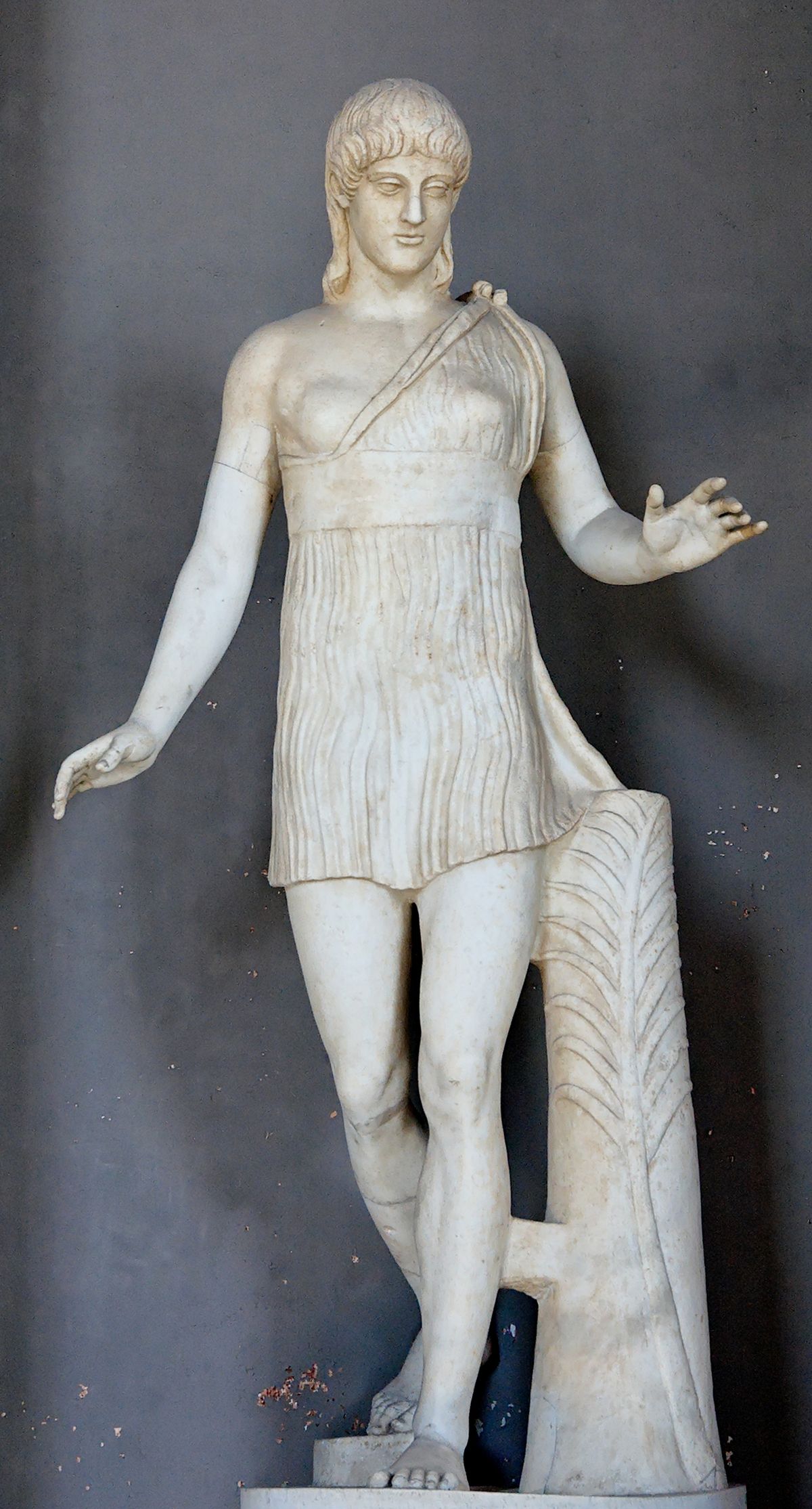
Atalanta: The Pride of the Arcadian Forest
It is rather tedious, isn't it? You know, the story of the helpless female held captive by some malignant male until a kindly god, noble paladin or well timed wind gust intervenes on her behalf. One would think that the mythological universe teems with frail ladies dependent on strong men for shelter and protection. In fact, it doesn't. While we're up here among them, we'd be well advised not to come to cross purposes with the female sirens, furies or fates. Also, we should be on our best behavior in the presence of the formidable Athena or the furious Hera. And, while we're at it, let's be polite to the Dryads and Graeae ladies, as well. Lastly, let's give a wide berth and offer a gracious smile to Atalanta, the perfectly self possessed and prepossessingly beautiful warrior/huntress.
Atalanta's story begins promptly at her birth. Her father, Iasus, king of Arcadia, so desperately wanted a son that when his daughter was born, he took her immediately to a mountainside and exposed her. Fortunately, a she-bear soon happened upon the abandoned infant and nursed her. The bear's milk imparted a preternatural strength onto the baby who matured quickly under the animal's care. When she was about five years old, the young girl was found by hunters who adopted her and gave her the name Atalanta, meaning simply "huntress." Under the tutelage of her adoptive family, Atalanta developed hunting skills surpassing all those who taught her. She devoted herself fully to the hunt and chase and in so doing became swifter than any other mortal. So blissful was Atalanta in her life, she determined to remain forever unmarried. Not only did her temperament incline her toward chastity, but she also heard an oracle warning her that any marriage would come to a disastrous end. She didn't need a man for happiness as life, itself, brought her fulfillment. Such was her speed and physical prowess that she required no protector, either. On one occasion, two centaurs, Rhoecus and Hylaeus, spied Atalanta and sought to rape her. Instead of fleeing, which would have been in vain as she could not outrun even the slowest centaur, Atalanta stood fast and slew both pursuers with her arrows. Being so strong and quick, she naturally craved adventure. She pleaded with Jason to let her sail on the Argo and join in the pursuit of the golden fleece. Jason, who well knew of her skill, reluctantly declined the offer. Jason wasn't stupid. He immediately recognized the dangers inherent in having a crew of more than forty men and only one woman. Later on, however, Atalanta was permitted to join the famous Calydonian Boar Hunt. This hunt was organized by Calydonian king Oeneus, whose kingdom was being ravaged by a giant boar. During the annual harvest, Oeneus had neglected to pay tribute to Artemis, goddess of the hunt and wild animals. Artemis punished this neglect by casting a boar into this kingdom. This creature was so ferocious it rapidly slew any soldiers that dared confront it. The boar so frightened the populace that nobody ventured outside. Crops failed and people began to starve. In desperation, Oeneus called for volunteers from around Greece to from a hunting party to seek out and kill the monster. This party included the king's son Meleager and his two uncles, Toxeus and Plexippus, the queen Althea's brothers. Meleager first saw Atalanta when all the warriors gathered for a feast prior to the hunt. Though most of the men, including Toxeus and Plexippus, were displeased at having a woman in her party, Meleager fell passionately in love with her. He kept near Atalanta during the hunt out of devotion. For her part, Atalanta regarded him merely as a hunting companion. The party sought the boar over many days until they finally surrounded it. The ravenous beast quickly killed three of the party before Atalanta struck it with her arrow. Meleager then went forth and killed the wounded boar with his dagger. Although the kill was technically his, the love-besotted Meleager presented the boar skin to Atalanta as she had drawn the first blood. Incensed, Toxeus and Plexippus came forward and ripped the skin from Atalanta's grasp. Meleager then engaged his uncles in combat, killing them both. In so doing, Meleager doomed himself. Years earlier, when Meleager was just a week old, the three Fates had appeared in his home and told his mother Althea that though her son would grow to be brave and famous, he would only live until the log presently burning in the hearth had been reduced to ashes. Horror struck, Althea doused the log with water and hid it in her closet. When word reached her that Meleager killed her two brothers, Althea furiously took out the log and set it blaze. By the time the log was reduced to ashes, Meleager had died in the arms of Atalanta who was distressed to have helplessly watched her brave comrade perish. The next morning Althea was so distraught at what she had done that she hanged herself.
Atalanta soon became famous for her exploits at the Calydonian Boar Hunt. As a consequence, many men wanted to marry her. Still determined to remain unwed, Atalanta devised a scheme she hoped would keep her single forever. Any man who wanted her as a wife would have to race her across a strip of land extending for many miles. The first man to win would become her husband. Many men tried to beat her in a race and they all failed miserably. Finally, a clever man named Milanion devised a scheme of his own. He appealed for help from Aphrodite the goddess of love and beauty. She was all too delighted to assist him in his efforts to win Atalanta for Aphrodite despised chaste women who were resistant to love's allure. The goddess gave him three golden apples so beautiful that every mortal who looked on them would want to possess them. Milanion challenged Atalanta to a race. She quickly accepted secure in the belief that she would again prevail. Soon after the race started, Atalanta ran ahead of Milanion. He then tossed one apple in front of her. Dazzled, she stooped to pick it up, thus allowing him to pull ahead. When Atalanta came abreast of him, Milanion tossed the apple off to the side. Yet again Atalanta couldn't resist and ran away to fetch the apple. As they neared the end, Atalanta caught up with him again. When they were both within a few strides of the finish line, he dropped the apple in front of her. By the time she stooped down to retrieve it, Milanion crossed the line and won the race. Per her agreement, Atalanta took Milanion as husband. The marriage, though brief, seemed relatively happy. The couple joyfully hunted together through the fields and forests of Arcadia. However, Milanion forgot to offer a sacrifice to Aphrodite out of gratitude for her assistance. So, one day, while Atalanta and Milanion were walking by the temple of Athena, Aphrodite smote them with a curse of intense desire. They made love in the temple much to Athena's chagrin. She transformed them both into lions for it was then believed that lions could only mate with leopards. By making them both lions, they could no longer satisfy their mutual desire. In this new form Atalanta became unwed again while remaining strong, fast and formidable. Perhaps to her view, the marriage didn't end disastrously after all.
THE SOUTHWORTH PLANETARIUM
207-780-4249 www.usm.maine.edu/planet
70 Falmouth Street Portland, Maine 04103
43.6667° N 70.2667° W
Altitude: 10 feet below sea level
Founded January 1970
Julian Date: 2458976.16
Julian Date: 2458976.16
2019-2020: CXLII
THE DAILY ASTRONOMER
Thursday, May 7, 2020
Thursday, May 7, 2020
Remote Planetarium 29: The Sun Part II: How We Know the Sun's Mass and Composition
Let's imagine the following scenario: While you're standing out in your yard, a planetarium astronomer drives up in his Lamborghini Aventador SVJ. He leans out of the window and asks, "Pardon this intrusion, but I was wondering if this month you would kindly give me the money you had intended to spend on your rent or mortgage?" You pause to consider the request. Yes, like all planetarium astronomers, this debonair boulevardier can beguile with a smile and entrance with a glance. On the other hand, you recognize that giving him the rent or mortgage money would place you in an uncomfortable position. If you miss a payment, the bank might initiate foreclosure proceedings or your landlord might threaten eviction. Though you have fallen deeply in love and it breaks your heart to have to do so, you regretfully decline. "Hmmm, that's the fourth decline today," the planetarium astronomer mumbles with bewilderment as he drives off in a huff.
Why did you decline?
Didn't you know that dashing astronomy guy would have paid off your entire mortgage or paid your rent each month for the rest of your life if only you had acceded to his request?! Yes, you thought that you might have lost your home had you given him the funds you had set aside for your monthly payment. Fact it, you wouldn't have lost your home at all. In retrospect your decision seemed rather foolish...no offense. Then again, you had no knowledge of what he intended to do for you.
So, bearing that matter in mind, let's regard the ancient rituals once performed around the winter solstice. From our modern perspective, these ceremonies seem, well, rather foolish. The intent of these rituals was, in part, to facilitate the Sun's ascent back to the high arcs it followed during the previous warm season. Our ancestors realized how Sun dependent they all were. (Someday their smug dependents will hopefully come to the same realization.) They knew that if the Sun's descent continued after the winter solstice, it would soon vanish from the sky altogether, plunging their world into perpetual darkness. We know that the Sun will always ascend after reaching the winter solstice point because we are aware of Earth's tilt.

Earth's tilt: Not to scale, thank heavens!
The rituals were performed by people who knew nothing of this tilt and so weren't aware that the Sun would always rise again even without their encouragement. The discovery of Earth's tilt and revolutionary motion allayed our winter solstice anxiety. However, we still knew little about the Sun until relatively recently. Humanity knew that it was reliant on the Sun, but knew nothing about how it generated its energy or how long it would last. (We'll address that issue on Monday). As we learned yesterday, it was only in the latter part of the 18th century that human determined the Sun's average distance of slightly more than 90 million miles. This distance determination was our first step in truly understanding not only the Sun's dimensions, but its nature, as well. The Sun subtends half an angle in our sky. In order to appear that large from a distance of 93 million miles, our Sun must be enormous. It is! The Sun is a sphere with a diameter exceeding 840,000 miles! Were it hollowed out, the Sun could accommodate 1.2 million Earth-sized spheres. See the image below.
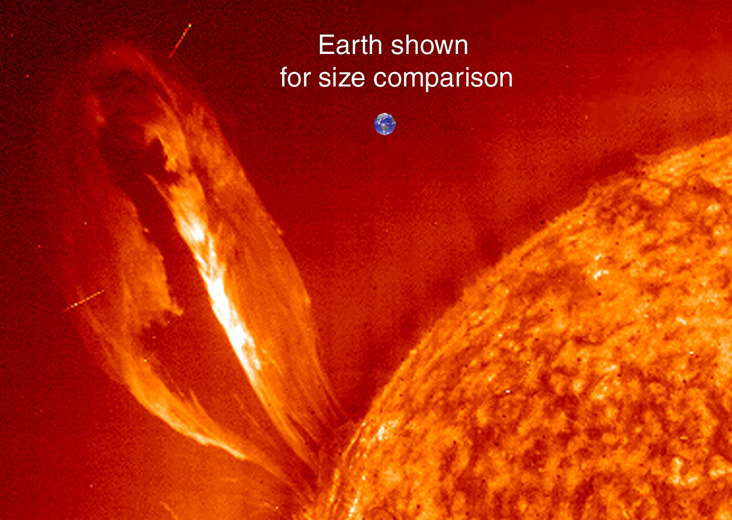
All the planets are minuscule compared to their parent star. It is little wonder at all that the Sun, not Earth, occupies the solar system's center. Being so large, the Sun must also be unfathomably massive! And, indeed, it is. Yet, how is it possible to "weigh" the Sun? Using mathematics and physics, of course.
First, we have to introduce the following equation:

The left side refers to the force of gravity between any two objects. For our purposes, M equals the Sun's mass; m = Earth's mass; r = Earth's orbital radius; and G is the "gravitational constant," a value indicating the strength of the gravitational force exerted between massive objects. G = 6.67 × 10-11 N m2/kg2 (where N is Newtons)
The right side refers to the centripetal "force" of Earth as it revolves around the Sun.
v = Earth's orbital speed; m = Earth's mass; r = radius of Earth's orbit
The gravitational force equals the centripetal force so we can equate these two formulae.
A little algebraic manipulation reduces the equation to the following:

By knowing Earth's orbital velocity, radius and the gravitational constant, we can accurately measure the Sun's mass.
The Sun's mass in kilograms is 2×1030
Or, to put it another way, the Sun is 330,000 times more massive than Earth. We will learn how important this mass value becomes when we try to determine the Sun's lifetime.
CHEMICAL COMPOSITION
Philosopher Auguste Compte (1798-1857) has joined the sad rank of philosophers who are best known for their mistakes. The astronomical world knows Compte primarily because of a now laughable prediction. In his 1835 publication "Cours de la Philosophie Positive" he wrote
On the subject of stars, all investigations which are not ultimately reducible to simple visual observations are ... necessarily denied to us. While we can conceive of the possibility of determining their shapes, their sizes, and their motions, we shall never be able by any means to study their chemical composition or their mineralogical structure ... Our knowledge concerning their gaseous envelopes is necessarily limited to their existence, size ... and refractive power, we shall not at all be able to determine their chemical composition or even their density... I regard any notion concerning the true mean temperature of the various stars as forever denied to us.
Fortunately, Compte was mistaken. Astronomers have managed to determine the chemical compositions, densities and temperatures of the stars.
Before we end today, we'll discuss the means by which they identified the chemicals within the Sun. Making this determination required examination of the Sun's spectra: the light it emits.
Let's first examine the visible light spectrum:
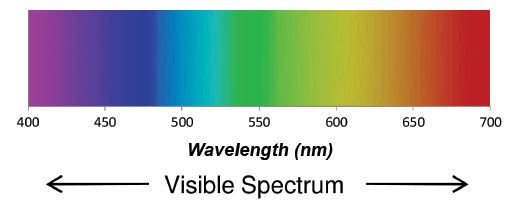
If we could split the visible light apart into its component colors we would notice a smooth continuous spectrum extending from red to violet. To remember the color sequence, think of the name Roy G. Biv Red-Orange-Yellow-Green-Blue-Indigo-Violet. A light source that does not pass through any other medium would produce a spectrum similar to the one seen above.
The Sun's light originates in its core and passes through the outer layers. As the light traverses the Sun's outer region, some of the photons are absorbed by atoms within that medium. When an atom absorbs a photon, one of the atom's electrons is elevated into a higher energy orbit. The atom then becomes "excited."
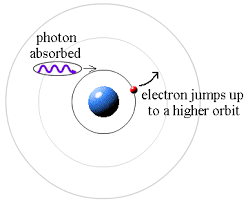
In this idealized model, the electron absorbs an incoming photon and is elevated to a higher energy orbit. The electron orbits are NOT as depicted, however. The more accurate term is "electron energy level."
Each atom absorbs photons at specific wavelengths. Consequently each atom produces its own "barcode" along the visible light spectrum.
The image below is provides an idealized example of such a spectrum;

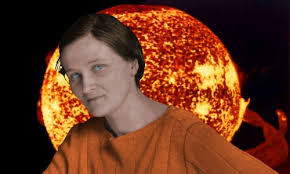
Dr. Cecilia Payne Gaposchkin
We know today that hydrogen and helium are the primary constituents of the Sun and other stars. The Sun also shows trace amounts of other materials, as well. The chart below shows the relative abundances of elements within the Sun. We can see that hydrogen is dominant followed by helium.
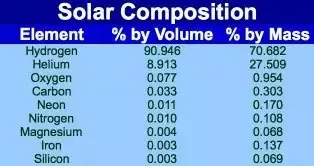
Knowing the Sun's size, mass and chemical composition are the next steps in our effort to truly understand how the Sun works and how long it will last. We'll continue with the Sun on Monday.
Tomorrow, another horrible quiz!
To subscribe or unsubscribe from the Daily Astronomer: